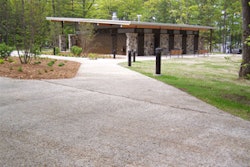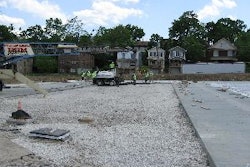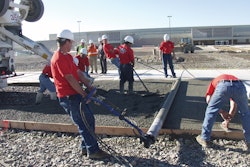
It's a bonanza, just waiting to be claimed.
The prize: almost 8 million U.S. green construction jobs that will pump $554 billion into the economy through 2013. And of that half a trillion dollars, an estimated $396 million is projected for wages.
The industry's upside potential was confirmed in the results of a study released this month by the U.S. Green Building Council and Booz Allen Hamilton.
Even before the survey of 19,000 USGBC member organizations, green construction spending accounted for more than 2 million American jobs and generated more than $100 billion in gross domestic product and wages from 2000 through 2008.
With government and private sector emphasis on new or retrofitted sustainable, energy-efficient or alternative energy facilities, the future of green building looks very rosy, indeed.
But how real is the opportunity?
While some of Colorado's national and regional construction companies expressed optimism for the opportunity, they also were concerned about the calculated risks involved. But like Dorothy, the Scarecrow, the Tin Man and the Lion, all are discovering the promising land of "green" at the end of the rainbow.
State and local opportunity
Those weighing in on the subject agreed that "green" projects would not only stabilize recession-ravaged construction employment, but would bring black ink back to the bottom line.
G.H. Phipps, the Denver-based construction company responsible for construction of the $56 million Science and Engineering building and the $12 million event center at the University of Colorado at Colorado Springs is already a green construction veteran.
The company has earned Leadership in Environmental and Energy Design gold or silver certification for its work at UCCS, Colorado College, the University of Denver, Colorado State University, the Boulder Community Foothills Hospital, the Colorado Springs Utility Lab and its headquarters building in Greenwood Village.
For Charlie Graft, the company's chief executive officer, the future requires diversification into new fields, including alternative energy and sustainable construction. With $150 million in projects already in its pipeline for 2010, the company announced it would work on research and development with Terra Moya Aqua, a manufacturer of low-profile wind energy systems.
The end product is targeted for use by commercial industry utilities companies, small businesses and homeowners. But manufacturing and installing the systems might be the easiest part.
"There's a lot of juggling and balancing to do - and we're still waiting to hear what the state's plan is for the smart grid," Graft said. "The success of a lot of alternative energy projects depends on that. "
Half a trillion reasonable
Bob Hansen, vice president and general manager for Mortenson Construction's Denver office said he's "comfortable" with the USGBC/Booz Allen Hamilton forecast for as much as $554 billion in sustainable and energy-related projects during the next four years - and with good reason.
Mortenson Construction has completed 90 LEED certified projects, representing more than $5.5 billion in renewable and green building.
"We're a $2.5 billion company," Hansen said. "Of that, about $700 million in annual revenue last year was generated by our renewable group. "
The company is implementing LEED-based construction principles at Fort Carson, where it has completed six company operations facilities and has six more under way - as well as work on 15 tactical equipment maintenance facilities.
Another of its green initiatives was a contract with Vestas, a Denmark-based wind power manufacturer, to construct 120-foot-tall wind blades.
Since entering the renewable energy market during 1995, Mortenson has been involved in the construction of more than 80 wind power projects, totaling more than 8,000 megawatts across the U.S. and Canada. The company also dedicates a large percentage of its 2,200 employees nationwide to renewable energy project teams.
Green glitter extends to retail
Demand for green construction practices has been driven both by customers and by Colorado Structures Inc. 's staff, said Vice President Rob Oldach.
The Colorado Springs-based general contractor is best known for building more than 150 Wal-Mart retail centers.
"Wal-Mart was doing it (sustainable building design) before it had a name - skylights, air handling, lighting and more," Oldach said. "They pioneered in energy management. We're also working right now on a Kohl's store which we'll submit for LEED certification. Our customers pretty much expect us to include green technologies and design in their facilities. "
He sees green construction as a strategic move for builders interested in staying busy.
"Generally you're just looking at a single digit percentage (additional cost) to qualify for LEED status," Oldach said. "So much can be captured by intelligent design and construction from the start. "
He said CSI plans to use green construction as a marketing tool for a speculative office building it just finished in Monument - promoting energy saving and sustainable features to prospect ive tenants.
"There's really no down side to it," Oldach said. "We're investing in our people so our project management teams can give more attention to details up front and throughout the entire process. "
Catastrophic rebuilders
Even Front Range niche companies such as BluSky Restoration Contractors have tweaked construction practices to capture growing requests for green construction.
The five-year old company with an office in Colorado Springs serves the emergency repair and mitigation construction market - an unlikely candidate for the move to green building, at first blush.
But Southern Colorado general manager Jason Cain sees tremendous upside.
"Some companies, like Traveler's Insurance, for example, are asking for code upgrades to include local green endorsements," he said. "Insurers are increasingly asking the restorer to find out what cities are requiring, especially in towns like Boulder where sustainable and green building is standard practice. "
BluSky also is putting additional resources and LEED AP manpower into providing property management companies like Griffis Blessing with smarter, more energy-efficient ways to reconstruct damaged rental units.
"Apartment owners are always looking for ways to stay profitable, to increase energy savings and extend the life of their facilities," he said.
Already a growing company, Cain foresees additional hiring for the firm's local offices.
"In our first five years, statewide we've grown from about $1 million to about $20 million in revenues, and going forward we will definitely be increasing our attention to sustainable construction," he said. "It's where the market's going. "


















